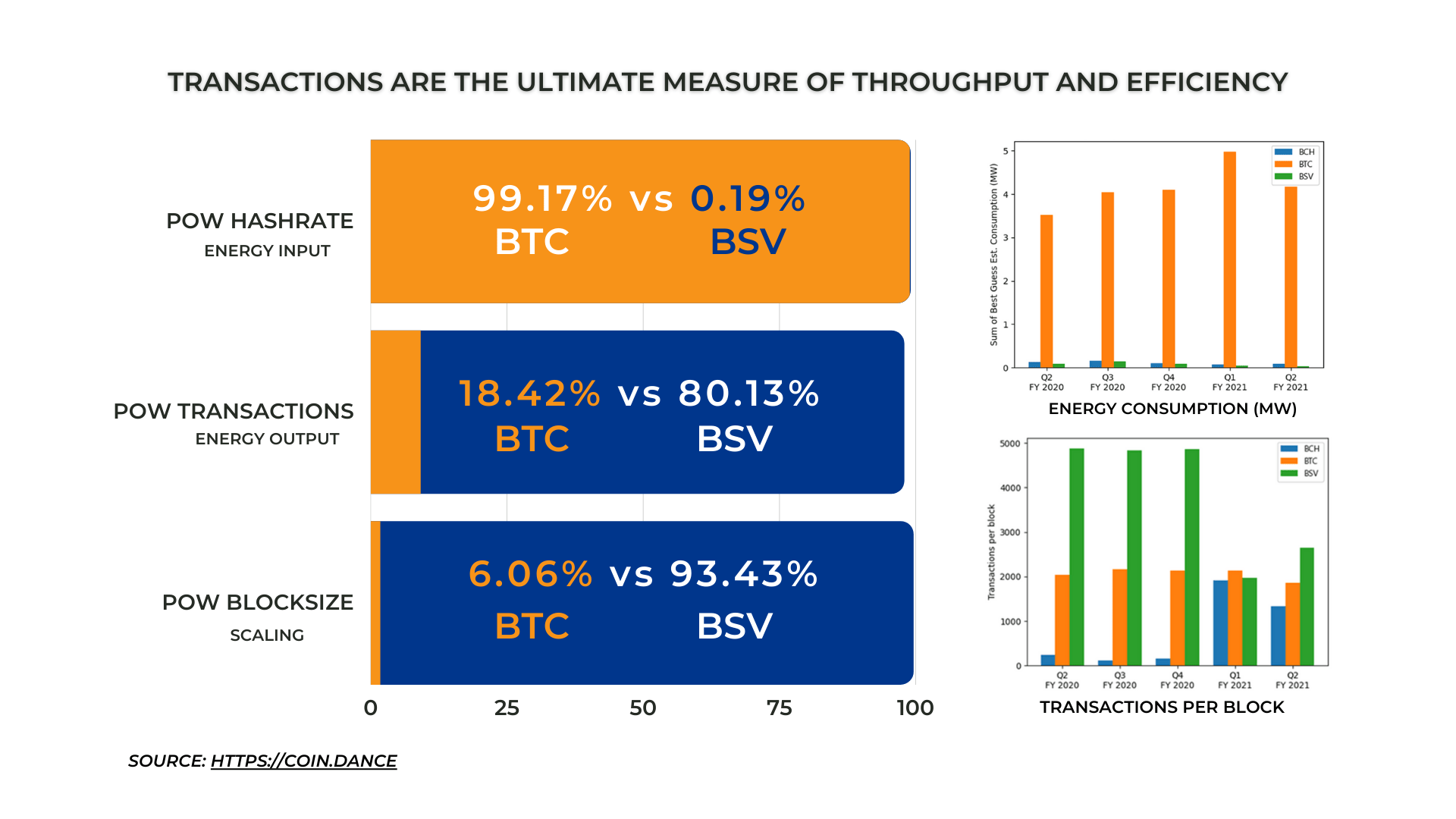Understanding Bitcoin Energy Consumption – CoinGeek

It is a common misconception that proof-of-work consensus algorithms are not scalable and consume too much energy due to the computational demands placed on miners.
This view has been reinforced by reputable online sources and institutions such as Digiconomist’s Bitcoin Energy Consumption Index which details the latest estimates of total energy consumption on the BTC network.
Their research conclusions, which are calculated based on BTC as a benchmark, would lead you to believe that “a quick fix to Bitcoin’s carbon footprint is not in sight.” However, this conclusion is wrong.
There are various attempted implementations of the Bitcoin protocol that have been developed, each with their own approach to improving the scalability of the technology. These different versions often compete with each other, as users and developers debate which approach is the most effective to tackle the challenges of scaling Bitcoin.
It is important to understand the utility of a digital asset and the real-world applications of blockchain technology to evaluate the energy consumption and overall value of the asset.
The complex and often confusing landscape of the cryptocurrency industry, with its mix of influential figures, fraudulent schemes and illegal securities, can make it difficult for even the most dedicated individuals to fully understand and follow developments in the field. However, it is worth noting that the underlying technology of blockchain is a significant technological innovation that is quietly revolutionizing various industries, although it does not always receive the same level of attention as the more volatile and speculative aspects of the digital currency market.
As for the question of whether the proof-of-work algorithm used by many digital currencies can scale effectively, the answer is not as complicated as the journey to reach it.
It is really challenging to defend the high energy consumption of the BTC network given its relatively limited utility. However, when the Bitcoin SV implementation (BSV) is considered in the same evaluation, the result is different: the BSV blockchain is the most sustainable implementation of the Bitcoin node.
Throughput is a measure of the speed at which actions are completed, and in the case of Bitcoin, it refers to the number of transactions that can be processed per second (TPS). BTC currently offers a relatively low TPS of between 4-7, but consumes a significant amount of energy due to the speculative nature of block reward mining.
The developers of BTC have primarily focused on developing off-chain solutions to improve scalability, but these efforts have resulted in fluctuations in the cost of transferring and exchanging BTC, due to the limited size of blocks (1mb) in BTC – the network.
Since the mining of block #556767 on November 15, 2018, Bitcoin SV (BSV) developers have made significant progress in breaking through scaling barriers previously thought to be impossible.
For example, on February 6, 2022, TAAL, a blockchain service provider, mined block #725511, which was a 3.8GB block with over 188,000 transactions with an average transaction fee of $0.005. In addition, during a live blockchain conference in June 2021, BSV demonstrated its ability to achieve a throughput of 50,000-100,000 transactions per second (TPS) in real time.
This is significantly higher than Visa’s reported capacity of 1,700 TPS, although the company claims to be able to handle up to 65,000 TPS. BSV has not only proven its ability to handle a large volume of financial transactions, but also has the potential to serve as a trustless ledger, a global shipping and supply chain infrastructure, an identity management solution and much more.
The BSV blockchain is the most sustainable node implementation
MNP, a leading accounting, tax and business consulting firm in Canada, has conducted extensive research on the topic of energy consumption in digital currency and recently published two reports examining the importance of the original Bitcoin protocol, the impact of changes to the popular BTC version on its capabilities , and how the competing version, BSV, has been able to exploit the native scaling capabilities that were present when the system was first released.
MNP’s independent blockchain technology’s energy consumption modeling confirms that block size and throughput have a significant impact on the efficiency of the proof-of-work algorithm.
The team used a combination of existing frameworks and input from industry experts to calculate the power consumption of the BTC, BCH and BSV blockchains, and validated their model with real-world data from miners, also known as transaction processors.
Scaling = Sustainability
MNP’s research revealed significant differences between the various Bitcoin protocols: specifically, that power consumption per transaction is significantly reduced when network utilization is higher on proof-of-work protocols with more permissive block sizes, compared to those with more restrictive block sizes.
The arbitrary limitations of BTC have a significant impact on power consumption per transaction. In contrast, MNP found that “BSV is the most efficient blockchain network compared to the other SHA-256 proof-of-work blockchains. With greater utilization and throughput, these reductions in consumption per transaction and increases in efficiency will only improve.”
This conclusion contradicts the common belief about the energy efficiency of Proof-of-Work protocols.
“After examining BTC and BSV against the original vision set forth in the whitepaper, forum posts, emails and other writings by Satoshi, it is our opinion that BSV is the implementation that currently best represents what Satoshi originally intended . BSV has a theoretically unbound block size, which allows payments to scale to the size of a Visa-like network without requiring an increase in fees to meet node operators’ financial demands. BSV also provides more functionality in terms of how developers can use the network to to build their own transaction systems on top of the Bitcoin protocol Source: MNP – The Original Bitcoin Protocol: What is it and why does it matter? August 25, 2021
What does this mean for Bitcoin energy consumption?
Scaling is critical to improving the energy efficiency of a digital asset secured by proof-of-work. By increasing the number of transactions per second (i.e. the transaction throughput), the energy consumption per transaction on a proof-of-work network is reduced.
This is due to the fact that the energy required to add a block to the chain is constant, regardless of the amount of data or the number of transactions included in the block. In other words, increasing the transaction throughput by one million results in a million doubling of the energy cost per transaction.
Researchers overwhelmingly agree that Proof-of-Work is the most secure consensus mechanism for verifying and ensuring the integrity and availability of transactions.
A mining facility’s purpose is to produce blocks of validated, time-stamped, ordered transactions. The energy needed to run a mining node is the same whether it validates 7 transactions per second or an unlimited number of transactions per second.

An analogy
The aviation industry contributes 5% of the world’s CO2 emissions. The CO2 footprint per passenger on daily flights is not a concern because of the huge benefits they provide. If an alternative mode of transport was proposed that was more efficient but less safe for transporting passengers, it would not be seriously considered due to the importance of human life at stake (ie the cargo being transported). It is not acceptable to compromise on necessary and necessary security for the sake of perceived sustainability.
But if a new form of travel was developed that required the same amount of energy per flight, but could carry an unlimited number of passengers, the CO2 footprint per passenger would be negligible.
Latest reviews:
Protection of critical national infrastructure requires the use of energy in relation to the required security level. This is true whether we are talking about protecting a country’s borders, secret secrets or data infrastructure.
Anything worth protecting requires efficient energy use. Resources are limited, so they must be used wisely to provide a competitive advantage or compromise risk.
Proof-of-Work provides a reliable model for resilience and security, including identifying assets and preventing fraud and risk, protecting critical infrastructure, detecting activities on a network, and responding and recovering from a security incident.
It is now up to blockchain experts, researchers and educators to break the false paradigm of the blockchain trilemma and embrace the scalable solution that bitcoin has always been, and BSV is demonstrating today, proving through sustainable, tool-based, enterprise and big data applications.
See: BSV Global Blockchain Convention panel, Blockchain mining and energy innovation
width=”560″ height=”315″ frameborder=”0″ allowfullscreen=”allowfullscreen”>
New to Bitcoin? Check out CoinGeeks Bitcoin for beginners section, the ultimate resource guide for learning more about Bitcoin – as originally envisioned by Satoshi Nakamoto – and blockchain.























